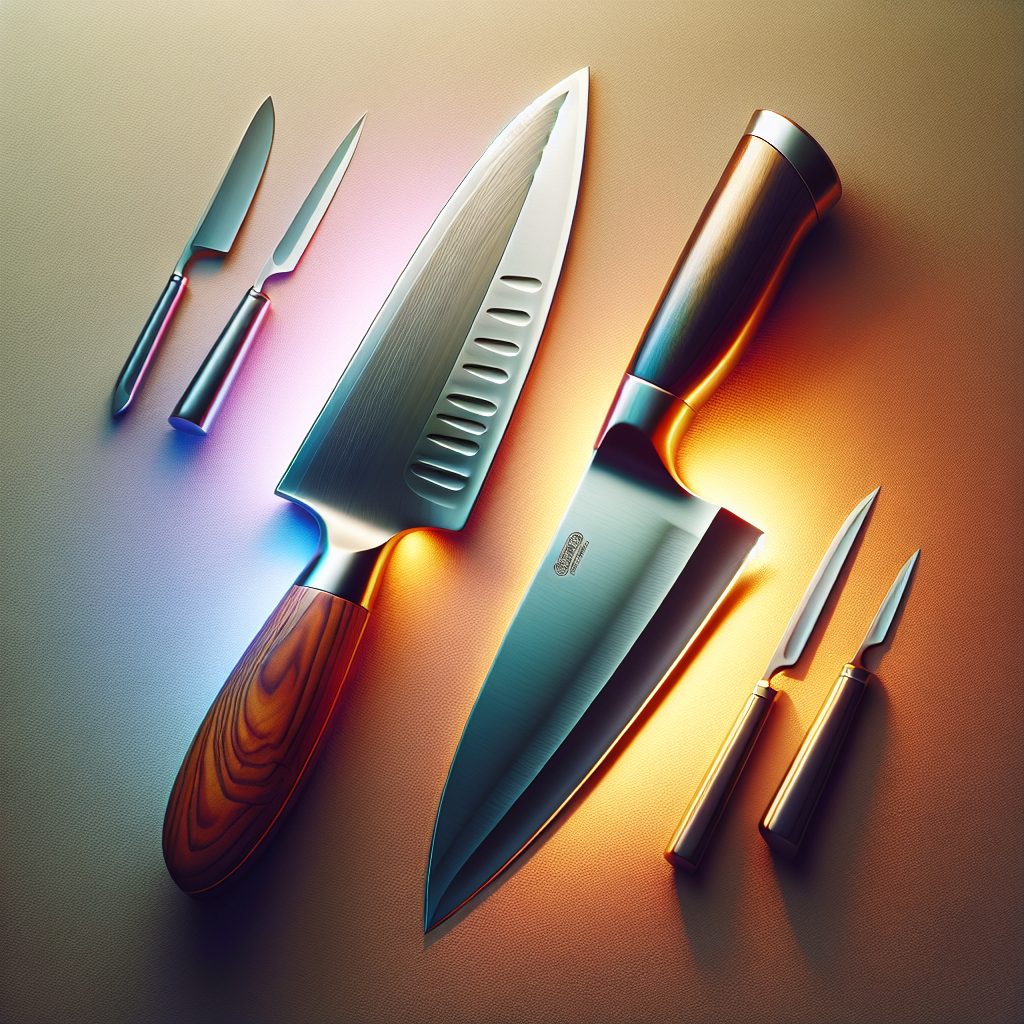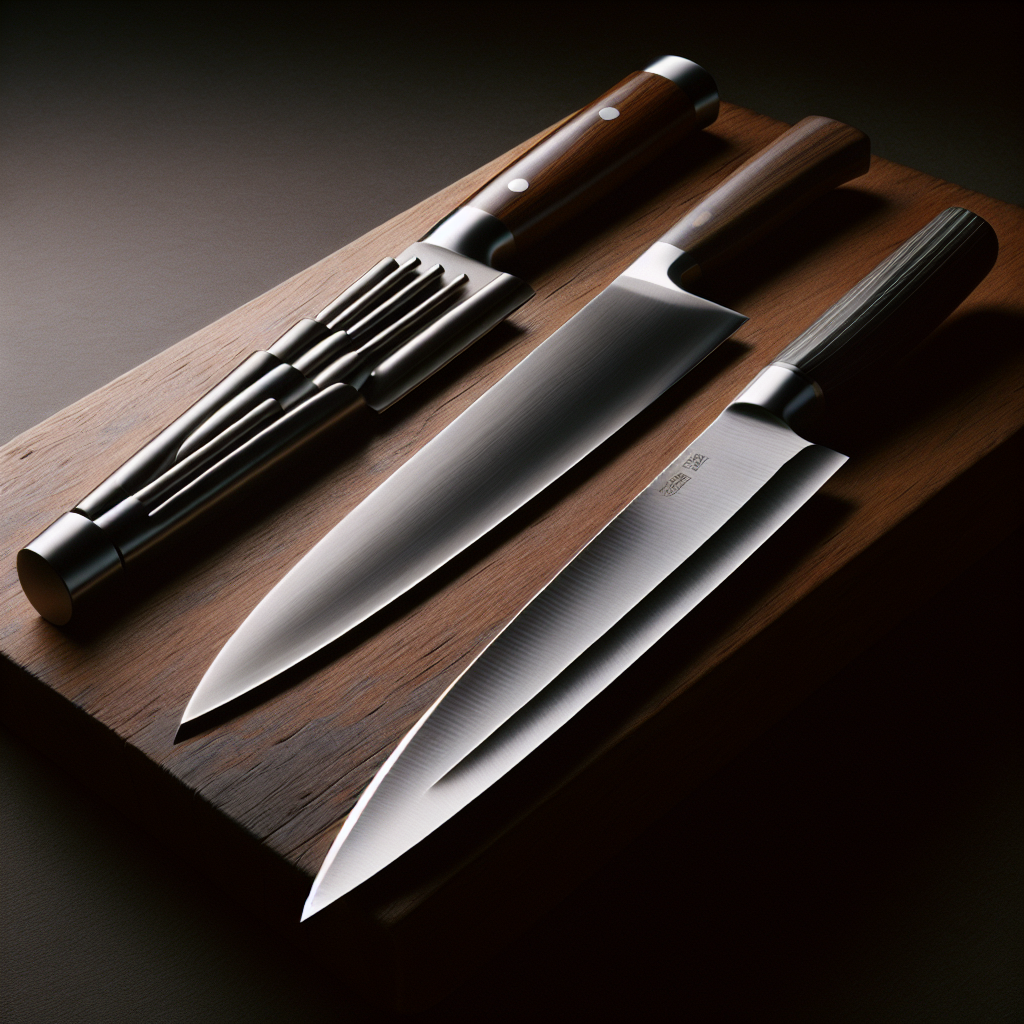What’s The Difference Between A Chef’s Knife And A Santoku Knife?
November 20, 2023

When it comes to slicing and dicing your way through the kitchen, two knives reign supreme: the chef’s knife and the Santoku knife. These versatile blade tools can be found in the hands of both professional chefs and home cooks alike, but what sets them apart? Let’s take a closer look at these kitchen essentials and unravel the mystery behind the differences between a chef’s knife and a Santoku knife. From their unique designs to the specific tasks they excel in, we’ll uncover the secrets to choosing the perfect knife for your culinary adventures. So, grab your cutting board and let’s slice into the world of kitchen knife mastery.

Size and Shape
Chef’s Knife Size and Shape
A chef’s knife, also known as a cook’s knife, typically has a large, broad blade that tapers to a point. This size and shape allows for maximum versatility and effectiveness in the kitchen. With a blade length ranging from 6 to 12 inches, a chef’s knife provides ample cutting surface for various tasks. The curved belly of the blade allows for a smooth rocking motion during chopping, making it ideal for slicing and dicing large quantities of ingredients.
Santoku Knife Size and Shape
In contrast, a Santoku knife is characterized by its shorter and wider blade. The word “Santoku” translates to “three virtues” in Japanese, referring to its versatility in slicing, dicing, and mincing. Typically, a Santoku knife has a blade length ranging from 5 to 7 inches. The wider blade provides greater surface area for scooping and transferring ingredients from cutting board to pot or pan. The straighter edge of a Santoku knife promotes a consistent chopping motion and is particularly well-suited for precision cutting.
Blade Design
Chef’s Knife Blade Design
The blade design of a chef’s knife is often curved, creating a rocking motion when cutting. This curvature allows for efficient chopping, as the entire length of the blade can be utilized. The tip of the blade is usually pointed, providing enhanced control and precision when working with intricate cuts.
Santoku Knife Blade Design
In contrast, a Santoku knife features a straighter blade design. The blade tends to have a more gradual curve, allowing for a simpler chopping motion with less rocking. The curved tip of a Santoku knife is less pronounced than that of a chef’s knife, resulting in a less aggressive stabbing motion. This design is favored by individuals who prefer a more linear chopping technique.
Blade Length
Chef’s Knife Blade Length
Chef’s knives typically come in a variety of blade lengths, ranging from 6 to 12 inches. The longer blade option offers greater versatility, allowing for efficient slicing of larger ingredients such as roasts or melons. However, a longer blade may feel cumbersome or less maneuverable for individuals with smaller hands or those who prefer more precise cuts.
Santoku Knife Blade Length
Santoku knives generally have shorter blade lengths, typically ranging from 5 to 7 inches. This shorter length contributes to the Santoku knife’s maneuverability, making it easier to handle and control. The compact size is particularly popular among home cooks who value agility and precision in their chopping tasks.

Blade Width and Spine
Chef’s Knife Blade Width and Spine
The blade of a chef’s knife is typically wider towards the heel and gradually tapers towards the tip. This width provides stability when cutting through thick or tough ingredients, such as squash or meat. Additionally, the spine of a chef’s knife is usually thicker, adding strength and durability to the blade.
Santoku Knife Blade Width and Spine
In contrast, the blade of a Santoku knife maintains a more consistent width from the base to the tip. This design promotes an even slicing motion and allows for greater control when performing intricate cuts. While the spine of a Santoku knife is generally thinner compared to a chef’s knife, it remains sturdy enough for most kitchen tasks.
Blade Edge
Chef’s Knife Blade Edge
The blade edge of a chef’s knife is typically sharpened on one side, creating a beveled edge. This asymmetrical design allows for greater precision and control during slicing and push-cutting techniques. However, it requires regular maintenance to maintain its sharpness and ensure an even cutting experience.
Santoku Knife Blade Edge
On the other hand, the blade edge of a Santoku knife is usually sharpened on both sides, resulting in a symmetrical edge. This ensures that the blade cuts through ingredients with equal effectiveness, regardless of whether the user is left or right-handed. The symmetrical edge also simplifies maintenance, as sharpening can be done evenly on both sides.
Cutting Technique
Chef’s Knife Cutting Technique
When using a chef’s knife, the recommended cutting technique is a rocking motion. Place the tip of the blade on the cutting board and use a gentle rocking motion to move the blade up and down while holding the handle. This technique allows for efficient chopping and slicing, as the curved edge smoothly guides the knife through the ingredients.
Santoku Knife Cutting Technique
In contrast, the cutting technique for a Santoku knife involves a vertical push or pull motion. Place the heel of the blade on the cutting board and use a downward or upward motion, applying even pressure along the length of the blade. This technique is excellent for precision cuts, such as slicing vegetables or boneless meats.
Versatility
Chef’s Knife Versatility
A chef’s knife is renowned for its versatility in the kitchen. Its size, shape, and design make it suitable for a wide range of tasks, including slicing, dicing, mincing, and even disjointing larger cuts of meat. Whether you’re working with vegetables, fruits, or proteins, a chef’s knife can handle it all with ease. It truly is the go-to knife for any culinary enthusiast or professional chef.
Santoku Knife Versatility
While a Santoku knife may not offer the same level of versatility as a chef’s knife, it still excels in many kitchen tasks. Its compact size and precise cutting ability make it ideal for slicing and dicing smaller ingredients, such as herbs, garlic, or shallots. The wide blade also allows for efficient scooping and transferring of ingredients, making it a great choice for seamless meal preparation.
Weight and Balance
Chef’s Knife Weight and Balance
The weight and balance of a chef’s knife play a crucial role in its performance and user comfort. Most chef’s knives have a slightly heavier blade, which aids in effortless cutting through denser ingredients. The weight is typically concentrated towards the blade, providing stability and control during slicing or chopping tasks. The handle is designed to balance out the weight distribution, ensuring a comfortable grip and reducing strain on the user’s hand and wrist.
Santoku Knife Weight and Balance
On the other hand, a Santoku knife tends to be lighter in overall weight compared to a chef’s knife. This lighter weight allows for increased agility and precision, making it easier to maneuver and control. While the balance may vary between different Santoku knives, their weight distribution often leans towards the handle, providing a comfortable grip and reducing fatigue during extended use.
Handle Design
Chef’s Knife Handle Design
Chef’s knives come in a range of handle designs to accommodate different preferences and hand sizes. The most common handle material is typically made of wood, such as walnut or rosewood, providing a traditional and aesthetic appeal. Some modern chef’s knives feature handles made of synthetic materials, like durable plastic or rubber, which offer improved grip and ease of maintenance. Ultimately, the handle design should prioritize comfort and allow for a secure grip during extended use.
Santoku Knife Handle Design
Santoku knives often feature a shorter, wider handle compared to chef’s knives. This design aims to provide a comfortable grip that accommodates various hand sizes and cutting techniques. Similar to chef’s knives, Santoku handles can be made from different materials, including wood, synthetic materials, or even a combination of both. The choice of handle material should prioritize comfort, grip, and durability.
Price
Chef’s Knife Price
Since a chef’s knife is considered a staple in any kitchen, it comes as no surprise that they can be found at a range of price points. The price of a chef’s knife varies depending on factors such as the quality of materials used, craftsmanship, and brand reputation. Entry-level chef’s knives can be reasonably priced, making them accessible to a wide range of users. However, high-end and professional-grade chef’s knives can be significantly more expensive, reflecting the use of premium materials and attention to detail.
Santoku Knife Price
Similarly, the price of a Santoku knife can also vary depending on factors such as brand, materials, and craftsmanship. Santoku knives are popular among both home cooks and professional chefs, resulting in a range of options in different price ranges. Entry-level Santoku knives can be affordable and provide reliable performance, while higher-end models may offer superior materials and additional features at a higher price point. Ultimately, it is essential to consider one’s budget, needs, and preferences when selecting a Santoku knife.
In conclusion, the difference between a chef’s knife and a Santoku knife lies in various aspects, including size and shape, blade design, length, width and spine, edge, cutting technique, versatility, weight and balance, handle design, and price. Each knife offers its unique advantages and excels in different kitchen tasks. Whether you choose a chef’s knife or a Santoku knife, both can be invaluable companions in the culinary world, helping you create delicious meals with precision and ease. The choice ultimately boils down to personal preference, cooking style, and the specific tasks you frequently undertake in your kitchen. So go ahead, equip yourself with the right knife and unleash your culinary creativity!
